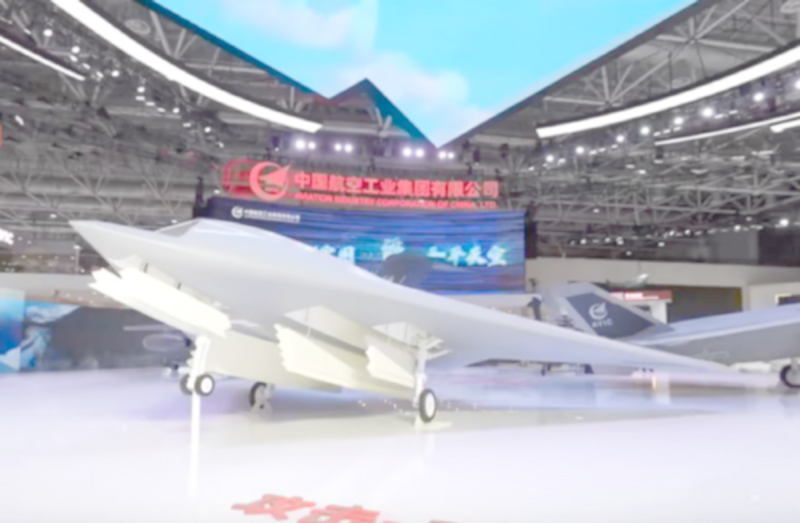If the recent Air Show China, formerly known as the Zhuhai Air Show, made a single lasting impression it’s the PLA’s unrecognized advantage in unmanned aircraft. Although the event, which is held every two years, is for promoting the domestic aerospace sector and its suppliers over time the emphasis on military technology has grown. For 2021 it was military technology in all domains that dominated the week-long event.
The state-owned AVIC in particular commanded an enormous pavilion for displaying its latest generation of aircraft. These included the J-20 stealth fighter, the Y-20 heavy lift transport, the Z-20 medium helicopter, and the GJ-11 stealth UCAV. (Pictured above.) The GJ-11 first came to the world’s attention in October 2019 when the Chinese military paraded all its newest weapon systems and technology. The display of so much equipment finally rubbished the long-held notion that the PLA’s kit is derivative and subpar.
The GJ-11 was carried on the bed of a truck and at the time its exact role was speculated. Other drones such as loitering munitions and a jet-powered spy plane were featured too. What was the GJ-11’s job, anyway? Analysis by the US-based think tank CSIS identified it as a “carrier-based UCAV” meant for aerial reconnaissance and long-range strike missions. Air Show China 2021 confirmed these very assumptions.
It’s a stealthy long-range strike aircraft with “swarming” potential; this means entire formations can be networked with a “mothership” like the J-20 stealth fighter or an AEW&C aircraft and conduct attacks independently. The implications of the GJ-11 on US allies in the first island chain are dire. China’s navy and air force have multiple long endurance drones at their disposal. If the PLAN’s upcoming carrier strike groups will be the main operators of the GJ-11 this means hundreds of stealthy UCAVs can impose air superiority over bodies of water and even geographical features. The air forces of Japan, Taiwan, and the Philippines in their present states aren’t equipped to deal with such a threat.
However, it’s possible the GJ-11 may only be in limited use if the PLAAF / PLAN diversify their drone fleets with different stealthy models. For example, the other state-owned aerospace manufacturer CASC has two models similar to the GJ-11. These are the CH-7, another single engine stealth UCAV whose appearance resembles the Northrop Grumman X-47B prototype a carrier-based UCAV with an uncertain future but with flight endurance and radius that matches most carrier-based aircraft, and a demonstrator called the CH-6 that conforms to the usual layout for MALE drones.
The CH-6 was put on display at Air Show China 2021 while the CH-7 was heavily promoted in the same venue four years ago. This year’s show featured a surplus of fixed wing UAVs for every conceivable mission. Questions persist about the payload of a stealthy UCAV such as the GJ-11. According to open sources drones of its size and engine type can take off with almost twice their empty weight but this depends on additional mission systems installed on the airframe and the munitions loaded into the weapon bays.
The GJ-11 clearly has two internal bays located in the space between its landing gear. Many Chinese state-owned manufacturers have catalogs of air-launched precision weapons and at this point there are so many glide bombs, loitering munitions, and even cruise missiles tailored for long endurance combat drones. Chinese air-launched munitions are combat proven, by the way, having proven their lethality in the Middle East and North Africa. Hence, the payloads a formation of GJ-11’s may carry are diverse and very threatening.
To be clear, not a single country in the Asia-Pacific fields a UCAV that matches the GJ-11 in appearance or performance, although Australia is now testing the Boeing Loyal Wingmana concept Chinese aerospace manufacturers have also embraced. Japan, South Korea, and Taiwan each have domestic unmanned aircraft programs of varying sizes but their collective efforts are moving at a snail’s space. To its credit, Korea Aerospace Industries (KAI) is working on a prototype jet-powered UCAV with a flying wing layout but its success is uncertain.
The proliferation of Chinese stealth UAVs and UCAVs can’t be downplayed. Should the PLA/PLAAF/PLAN deploy these in sufficient numbers local air forces will be strained and rendered ineffective, being unequipped and unprepared to secure their airspace against stealth aircraft, thereby assuring China’s success in expanding its sphere of influence. This puts the onus of territorial defense on ground-based resources such as multi-layered radars, electronic warfare, road mobile SAMs, and possibly direct energy weapons. But investing in these still takes years and can strain overstretched government budgets.


